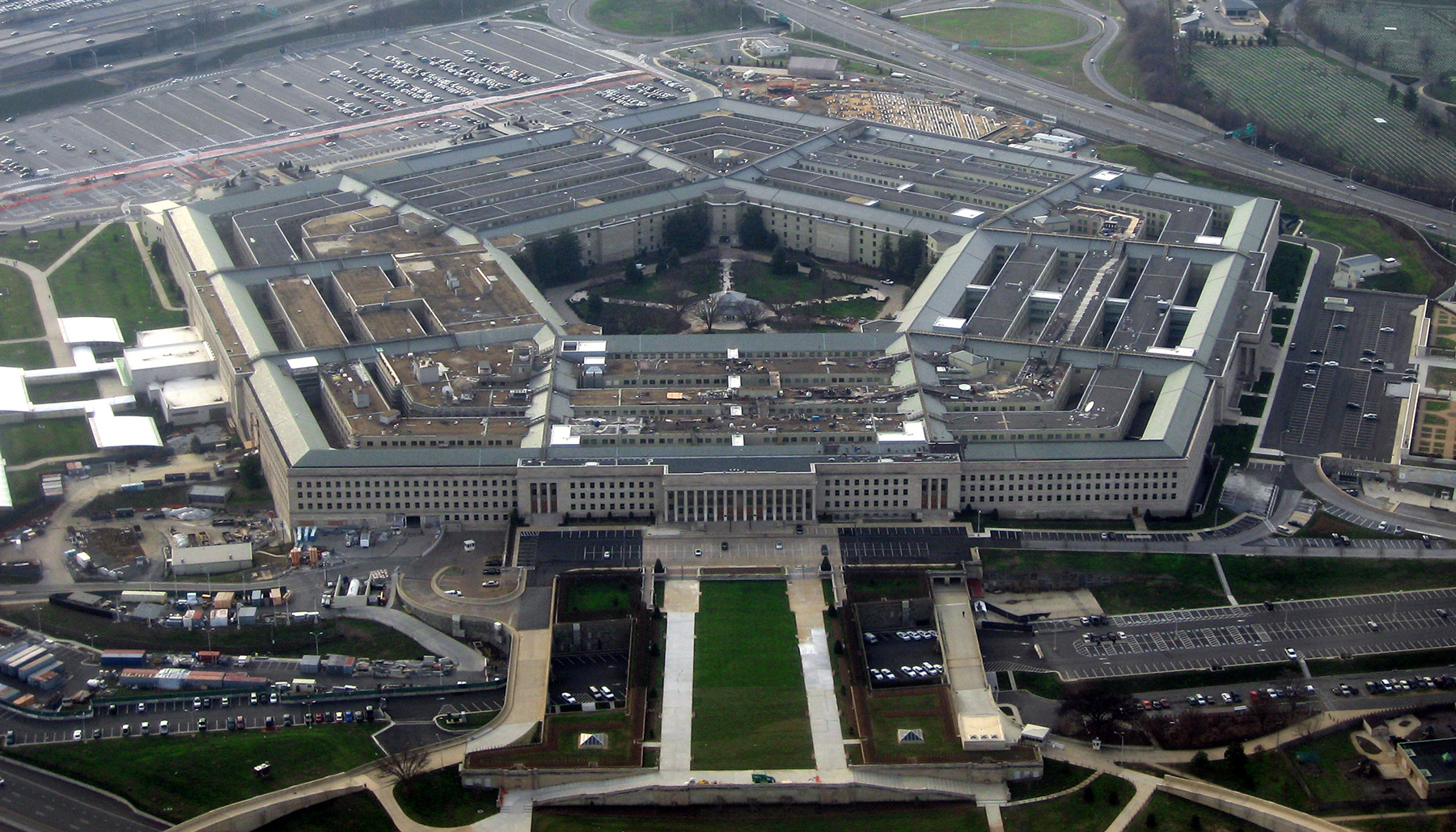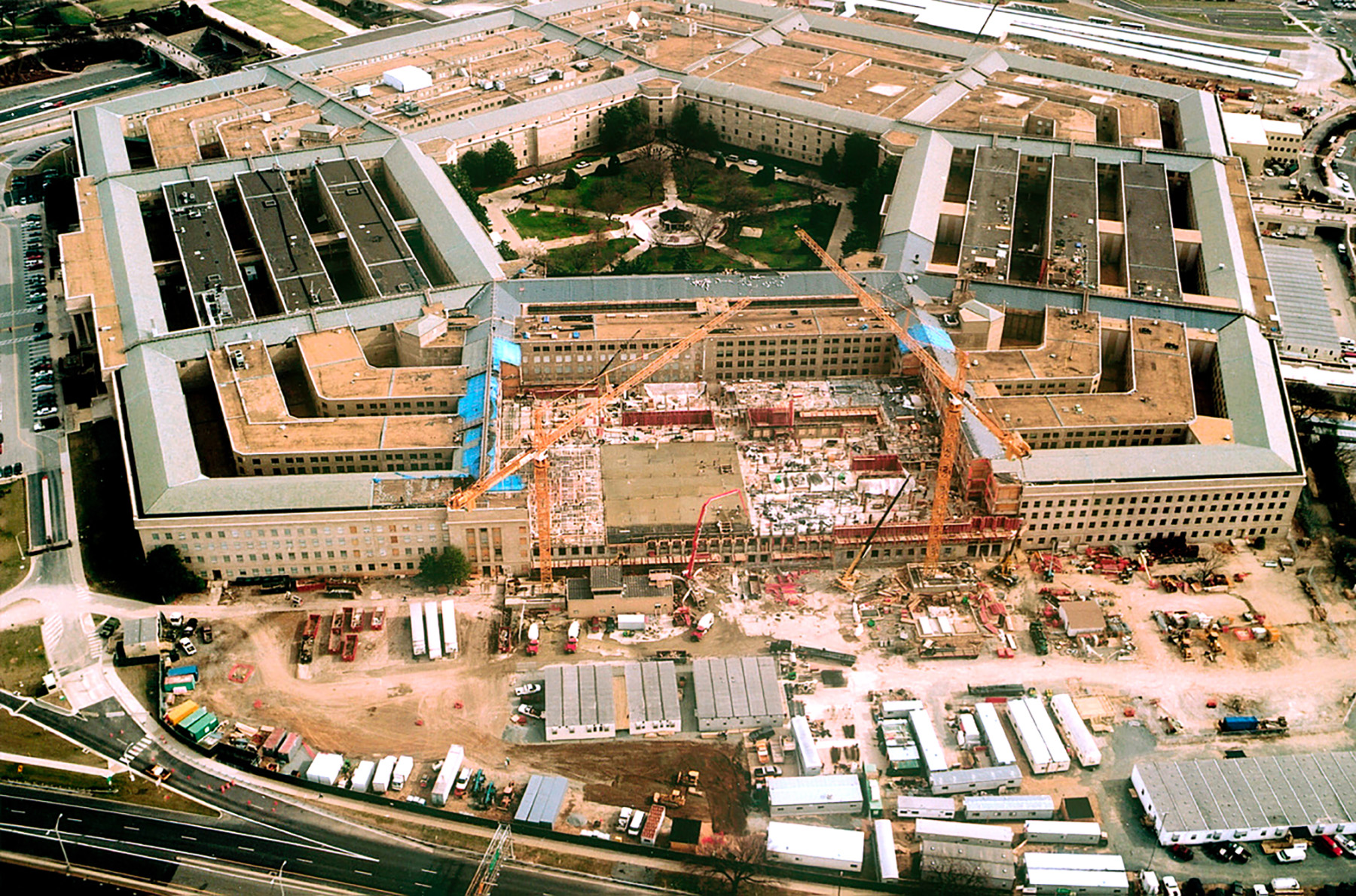
Introduction by Laurie A. Shuster and excerpt by Richard A. McSeveney, P.E., M.ASCE, Sean M. Buckley, P.G., Betsy Strohecker, LEED AP BD+C, Ehab M. Hanna, M.ASCE, and David E. Husson, LEED AP
When terrorists flew Flight 77 into the Pentagon on the morning of Sept. 11, 2001, a massive renovation effort was already underway to bring the 60-year-old Pentagon — thought to be the world’s largest office building — up to date and into compliance with modern building codes.
Program and construction management services for the renovation were being provided by a joint venture of AECOM and Parsons. For the renovation, they had divided the Pentagon into wedges consisting of a corner and half the length of one side of the building and extending in both directions from the corner. Work was to proceed on one wedge at a time, with employees moving from one wedge to the next as the work proceeded.
Flight 77 was flown primarily into wedge 1, where the first phase of the renovation had been nearly completed, and those upgrades helped save lives. This month, as civil and structural engineers reflect on the anniversary of the attacks and how they affected the profession, it may be useful to understand what had been renovated at the Pentagon and how the renovation project was impacted and completed.
Presented below is an excerpt from “Rebuilding the Pentagon,” by Richard A. McSeveney, P.E., M.ASCE; Sean M. Buckley, P.G.; Betsy Strohecker, LEED AP BD+C; Ehab M. Hanna, M.ASCE; and David E. Husson, LEED AP, published in the September 2011 issue of Civil Engineering.
The Pentagon renovation plan was approved in 1990 and envisioned renovating the building wedge by wedge — each wedge enveloping approximately 1 million sq ft. The plan called for first stripping each wedge to its base structure to remove asbestos (and) for entirely new mechanical, electrical, and plumbing systems, sprinkler systems, vertical transportation, information technology systems, and security systems, including blast-resistant windows. It also called for improvements in fire and safety systems and a flexible universal space plan to accommodate changing mission needs. The large number of Pentagon personnel (roughly 25,000) and the critical nature of their missions — plus the sheer magnitude of the (roughly 6 million sq ft) building — posed challenges unlike those encountered in any other renovation project.

At 9:37 on the morning of Sept. 11, 2001, the terrorists who had taken control of American Airlines Flight 77 — a transcontinental flight bound from Washington Dulles International Airport to Los Angeles International Airport — crashed the plane into the Pentagon, killing 184 innocent victims and damaging a portion of the structure. This terrorist attack on the Pentagon altered the renovation program in that increased emphasis was placed on force protection and life safety. The schedule was also accelerated dramatically.
Despite the tremendous impact of the plane and the ensuing fire that was fed by the plane’s fuel, the renovated area did not collapse for (20) minutes. That gave many Pentagon employees, some of whom were directly above the area of impact, adequate time to escape. Most of the new window units remained intact, preventing severe injuries and possible loss of life. However, old window units in wedge 2, some of which were up to 200 ft away, blew out during the initial impact and deflagration.
The renovation of wedge 1 was just five days short of completion when the plane struck. The aircraft traveled through the structure at a roughly 45-degree angle to the face of the building. It tore through wedge 1 and penetrated the unrenovated wedge 2. Within minutes of the plane’s impact, renovation team members were engaged in emergency response, disaster evaluation, and recovery planning. The team gathered and reproduced structural drawings for the Federal Bureau of Investigation and crash recovery teams, and it provided personnel, equipment, and materials for the rescue and recovery effort. Within 24 hours the renovation team had also prepared a damage assessment and a recovery strategy that were presented to the secretary of defense for approval.
The fire burned for nearly three days. In addition to fire and smoke damage, water damage and mold caused by the thousands of gallons of water that flooded the building triggered health concerns. Air was monitored daily for mold, asbestos, lead, and silicate. Once the FBI turned the site back over to the renovation team, hazardous conditions were quickly brought under control and acceptable air quality levels were achieved.
The damage initially affected more than 1.5 million sq ft. Just three days after the attack, the Pentagon Renovation and Construction Program Office awarded contracts to begin reconstruction of the damaged areas and resume the renovation program. In areas of wedge 1 that had sustained less extensive damage, the cleanup of water, smoke, and mold progressed rapidly. Crews worked around the clock to replace drywall, restore electric power and communications capabilities, install new carpet, and replace furniture.
At 10:30 a.m. on Sept. 11, KCE Structural Engineers P.C., a consulting firm based in Washington, D.C., was called in to provide emergency assistance in reconstructing the most severely damaged portion of the building. The year-long effort (was) known as the Phoenix Project.
At the time of the attack the renovation team had just informed Hensel Phelps Construction Co., of Greeley, Colorado, that it had been selected for the design/build renovation of wedges 2 through 5. (AECOM was the engineer of record for wedge 1.) The terrorist attack made it necessary to complete the building’s safety and security enhancements earlier than originally planned. Congress appropriated additional funding to accelerate the overall renovation schedule. The team decided to continue with the wedge 2 renovation concurrently with the Phoenix Project.
Wedge 2 was resequenced to recover time lost because of the attack and to accelerate the rebuilding effort, and it was the first wedge to be completed under this accelerated schedule. The comprehensive activity schedule included not only traditional design and construction activities but also all activities by other contractors working in wedge 2 (for example, all information technology activities, elevator work, security work, furniture installation, and relocation services).
In the aftermath of the attack, the renovation team (also) oversaw the reconfiguration of roadways in and around the 276-acre Pentagon (site). The primary objective was to move the roadways away from the Pentagon, mitigating the threat of truck bombs. A secondary objective was to ease burdensome new restrictions imposed on commuters using the area roadways. A secure bypass was constructed through the north sector of the Pentagon reservation. Fences, bollards, walls, and engineered, filled berms were installed along Route 27 to prevent unauthorized access to the Pentagon and provide additional blast protection.
Prior to the Sept. 11 attack, the Pentagon had begun making security changes in the aftermath of the Oklahoma City and Khobar Towers bombings. The $34 million, congressionally mandated security upgrade involved the relocation of the Pentagon bus and rail facility overseen by the Washington Metropolitan Area Transit Authority and the construction of a secure entrance facility. (The original entrance to the underground train opened directly into the building, posing a threat to security and potentially allowing hazardous fumes and contaminants to enter the Pentagon from the station.) The new facility is the largest intermodal transit facility in northern Virginia.
The goal to reoccupy wedge 1 was met through around-the-clock construction, and that portion of the building was rededicated and occupied on Sept. 11, 2002. Wedge 2 was completed on time, as were wedges 3, 4, and 5. In accordance with a Congressional mandate, construction was completed three years earlier than called for in the original schedule.
At the time of publication, Richard A. McSeveney, P.E., M.ASCE, was the director of the AECOM/Parsons joint venture, providing program and construction management services for the Pentagon renovation program. Sean M. Buckley, P.G., was the deputy director of the AECOM/Parsons joint venture. Betsy Strohecker, LEED AP BD+C, was the former deputy director of the AECOM/Parsons joint venture, having served the program for 11 years, and was a vice president with Parsons. Ehab M. Hanna, M.ASCE, was a senior AECOM construction manager and had been with the renovation program since 1998. David E. Husson, LEED AP, was a senior AECOM construction manager and had been with the renovation program for five years.
Laurie A. Shuster is the editor in chief of Civil Engineering.
This article first appeared in the September/October 2021 issue of Civil Engineering.
Read the next article in the collection: "A remembrance: The World Trade Center towers and the engineers who designed them."



